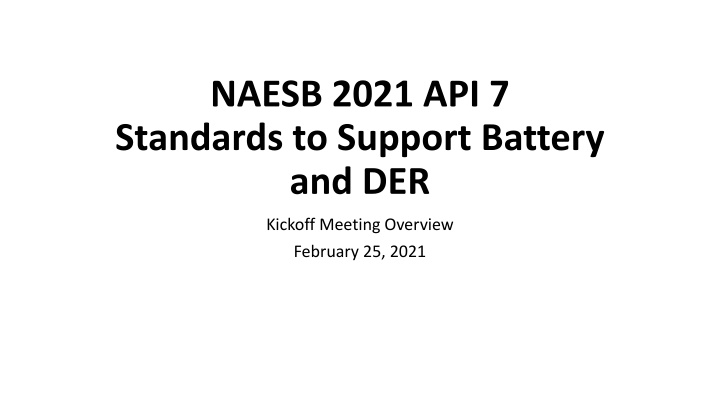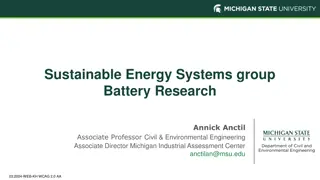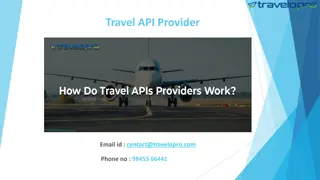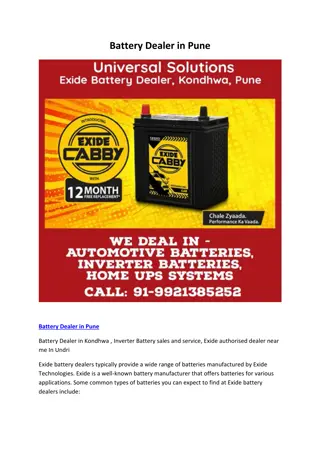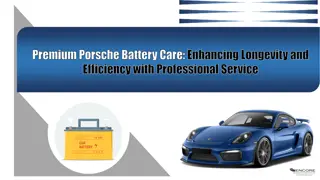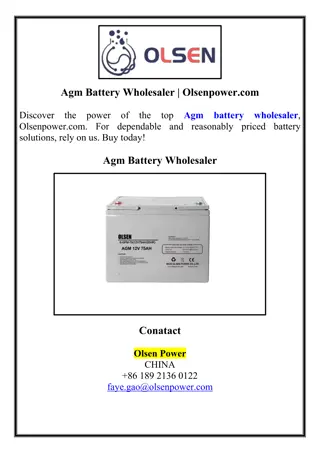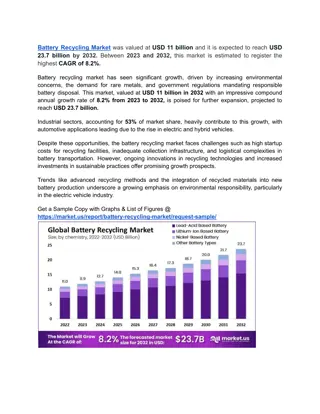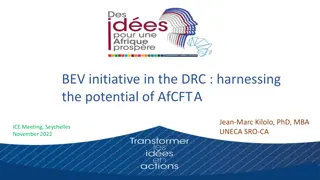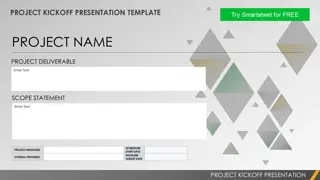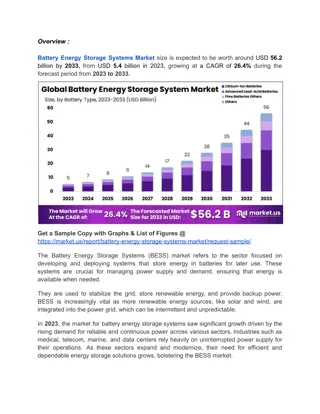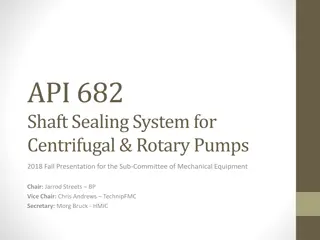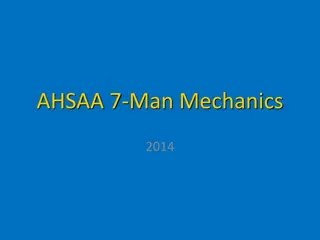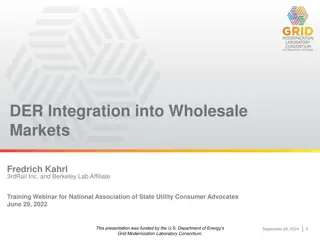NAESB 2021 API-7 Standards for Battery and DER Kickoff Meeting Overview
Overview of the kickoff meeting discussing the development of NAESB 2021 API-7 standards to support battery and distributed energy resources. The meeting emphasized consensus-based standards development following the ANSI SDO process. Key topics included mission objectives, industry guidance, and foundational use cases. The focus was on developing business practices and standards to facilitate interactions between ISO/RTO and DER aggregators, aligning with FERC Order 2222 and 841.
Download Presentation

Please find below an Image/Link to download the presentation.
The content on the website is provided AS IS for your information and personal use only. It may not be sold, licensed, or shared on other websites without obtaining consent from the author.If you encounter any issues during the download, it is possible that the publisher has removed the file from their server.
You are allowed to download the files provided on this website for personal or commercial use, subject to the condition that they are used lawfully. All files are the property of their respective owners.
The content on the website is provided AS IS for your information and personal use only. It may not be sold, licensed, or shared on other websites without obtaining consent from the author.
E N D
Presentation Transcript
NAESB 2021 API 7 Standards to Support Battery and DER Kickoff Meeting Overview February 25, 2021
Consensus Based Standards Development Follows the ANSI SDO process The WEQ BPS subcommittee will decide what to focus on to achieve the annual plan items described in this work paper Work Papers are not Prescriptive, they are presented as a means to initiate discussions (sometimes submitted by a single individual) The decision on what we do first, and the scope of work for this initiative will be decided by group consensus in the WEQ BPS Subcommittee A description of NAESB s standards development process is available here: https://naesb.org/misc/NAESB%20Procedure%20Summary.pdf
Topics Mission Overview Key Drivers Industry Guidance Foundational Use Case Focus Next Steps
Three NAESB Annual Plan items 7. requirements to support battery storage/energy storage and, more broadly, distributed energy resources in front and behind the meter. Standards applicable to qualified wholesale participants, e.g. FERC Order No. 841, should take precedence. a) Develop business practices that define an index/registry for qualified energy storage resources and distributed energy resources participating in the wholesale markets b) Develop business practices for information and reporting requirements for the qualified energy storage resources and distributed energy resources participating in the wholesale markets c) Develop business practices to establish performance metrics for the qualified energy storage resources and distributed energy resources participating in the wholesale markets Develop and/or modify standards for information and reporting
Mission Objectives Focus on foundational requirements for market based interactions between ISO/RTO and DER Aggregator as a first priority Identify specific use cases and market interactions that are in-scope for an initial release of the standards supporting 7(b) Develop data element names, definitions and structures for in-scope use cases and market interactions Overarching Goal: Produce Version 1.0 of a business practice standard for item 7(b) that enables foundational interactions between ISO/RTO and DER Aggregator, that can also serve as input to 7(a) and 7(c) and as a baseline for future 7(b) standards work.
Key Driver: FERC Order 2222 and 841 RTOs/ISOs must amend their tariffs to allow DER aggregators to participate in their markets. Defines a DER as any resource located on the distribution system, any subsystem thereof or behind a customer meter. Defines a DER aggregator as the entity that aggregates one or more DERs for purposes of participation in the capacity, energy and/or ancillary service markets of the RTOs and/or ISOs. The DER aggregator is the RTO/ISO market participant DER aggregator is single point of RTO/ISO contact: responsible for managing, dispatching, metering and settling the individual resources. Minimum size requirement for DER aggregations can be no more than 100 kW. Rule does not adopt a maximum size for a DER aggregation. Each RTO/ISO must propose locational requirements that are "as geographically broad as technically feasible," which may include multi-node aggregations. RTOs/ISOs must allow dual participation in retail programs and allow DERs to provide multiple wholesale services; they may create accounting/operational rules to avoid double payment. Reference FERC Presentation: https://www.energy.gov/sites/prod/files/2021/02/f82/FERC_Kathan.pdf
Additional Order 2222 Items Address information and data requirements for DER aggregations Address modifications to the list of resources in a DER aggregation Address metering and telemetry requirements for DER aggregations Address coordination between the RTO or ISO, the DER Aggregator, the distribution utility, and the relevant electric retail regulatory authorities
Foundational Use Case: Registration Process Initial Notification of Intent to Register a DERA Eligibility Confirmation Registration and Activation Updates to an Existing DERA Registration (portfolio of DER s) Reference ISO New England Presentation: https://www.iso-ne.com/static-assets/documents/2021/01/a0_order_2222_draft_high_level_market_design_approach.pptx
From WEQ 18 - Registration Service Provider System Operator SO Receives Verification Response Sends to SO Sends to TDSP; LSE; MA; SE for verification SO Distributes Message of outcome to all actors Consider if qualification required SO responds to SP of outcome
Registration Potential Approaches RTO Centered RTO manages the registration process Transmission Provider Meter Agent Changes by one entity require recertification by the RTO Each RTO may follow different process for each interaction Distribution Utility Scheduler Questions regarding directions to Regulator or Distribution Utility RTO DERA Regulator
Registration Potential Approaches Central Index of Distributed Energy Resource (CIDER) RTOs utilizes industry repository like the Electric Industry Registry Transmission Provider Load Serving Entity Any DER or DERA changes get logged in centralized ledger and approval processes managed by that repository Meter Agent Common registration approach among RTOs DERA Scheduler Varied data requirements can be managed within the ledger RTO can require registration through its Tariff CIDER RTO Regulator Dispute resolution are through industry consensus process and managed by the Ledger
In-Scope Interactions: Registration Use Case FERC Order 2222 Coordination Requirements for RTOs/ISOs: Coordination Requirements Must revise its tariff to establish market rules that address coordination between the RTO/ISO, the DER aggregator, the distribution utility, and RERRAs. Must incorporate a comprehensive and non-discriminatory process for timely review by a distribution utility of the individual DERs that comprise a DER aggregation Must establish a process for ongoing coordination, including operational coordination, that addresses data flows and communication among ISO/RTO, the DER aggregator, and the distribution utility. Must identify how to accommodate and incorporate voluntary RERRA involvement in coordinating the participation of aggregated DERs in RTO/ISO markets. (STRAWMAN PROPOSAL ONLY) Define data elements needed for coordination between DER Aggregator and ISO/RTO for the following foundational wholesale market interactions: DER Aggregator registration DER Resource registration DER Facility registration DER Resource portfolio management (list of facilities being aggregated in DER Resource) DER Resource status declarations (i.e. unit operating mode/status) DER Facility within portfolio status declarations (similar to above but at facility level)
Registration Data (Example only) Electrical interconnection information for DERs is required by the ISO to review potential transmission impacts and forecast adjustments Interconnection bus name Interconnection voltage level Metering domain Aggregation Zone, Load Zone, or substation pnode (as specified elsewhere in the ISO s Order No. 2222 compliance proposal) Provide a complete list of all DER facilities comprising the DER Aggregator s portfolio of facilities, which includes the following: Service addresses and retail account IDs (if applicable) Asset Name Metering domain and applicable location (DRR Aggregation Zone, Load Zone, or substation pnode) Host Participant/Distribution Utility Asset Ownership Meter Reader and metering interval (hourly vs. 5 min) Estimated Max Load/Maximum Consumption Seasonal Max Net Output Corresponding FCM Resource ID, if applicable Proposed technologies to be utilized Reference ISO New England Presentation: https://www.iso-ne.com/static-assets/documents/2021/01/a0_order_2222_draft_high_level_market_design_approach.pptx
Questions to consider Do the NAESB DR standards include the DER proposed by the FERC? Would the industry benefit from a single repository of DER? How will these standards efforts align with the direction of the RTO markets?
Next Steps Discuss starting points Address known questions Reach consensus on the In-Scope Foundational Use Cases and interactions to focus on first
